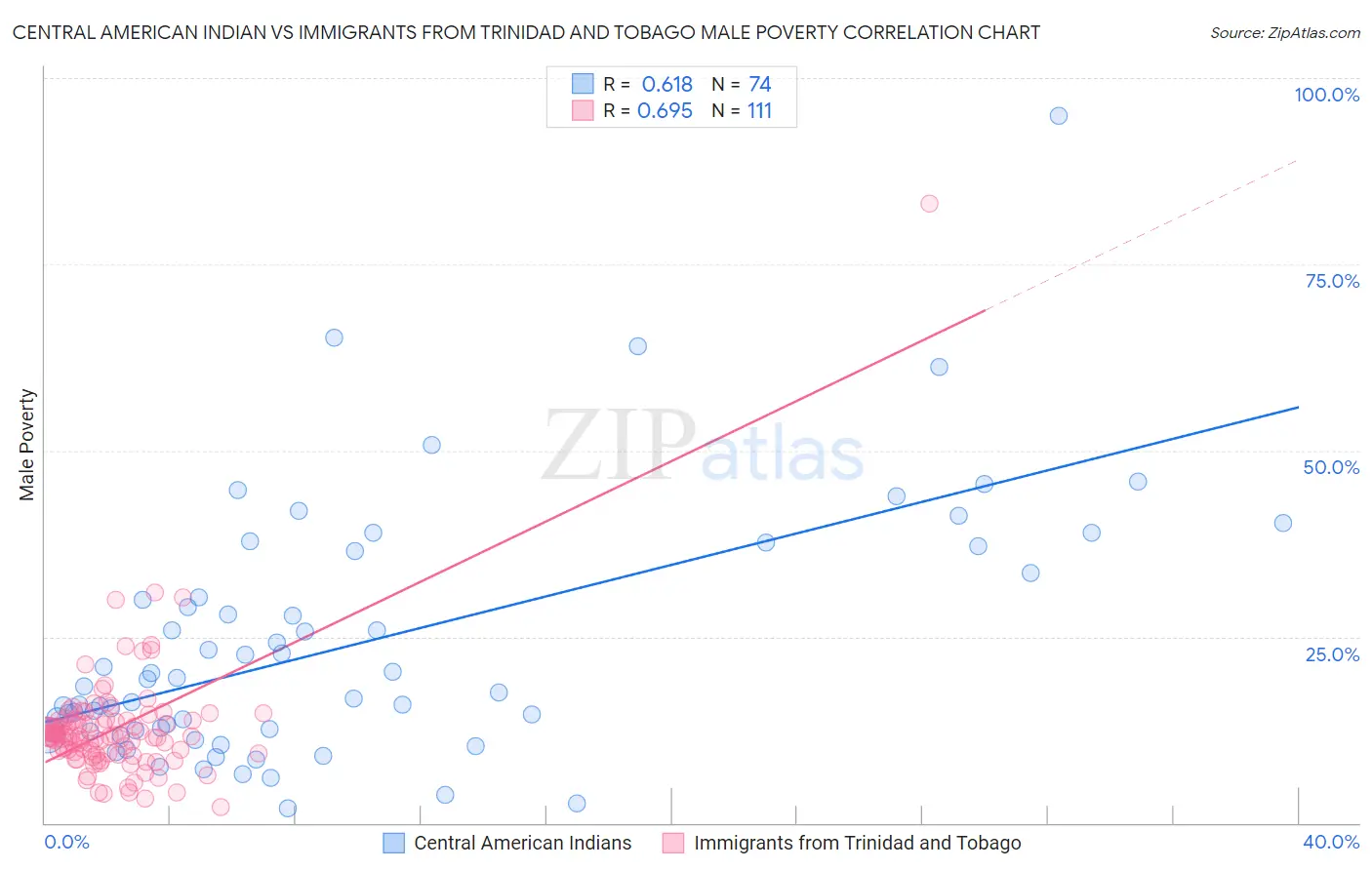Central American Indian vs Immigrants from Trinidad and Tobago Male Poverty
COMPARE
Central American Indian
Immigrants from Trinidad and Tobago
Male Poverty
Male Poverty Comparison
Central American Indians
Immigrants from Trinidad and Tobago
15.3%
MALE POVERTY
0.0/ 100
METRIC RATING
326th/ 347
METRIC RANK
13.1%
MALE POVERTY
0.1/ 100
METRIC RATING
257th/ 347
METRIC RANK
Central American Indian vs Immigrants from Trinidad and Tobago Male Poverty Correlation Chart
The statistical analysis conducted on geographies consisting of 326,052,023 people shows a significant positive correlation between the proportion of Central American Indians and poverty level among males in the United States with a correlation coefficient (R) of 0.618 and weighted average of 15.3%. Similarly, the statistical analysis conducted on geographies consisting of 223,466,412 people shows a significant positive correlation between the proportion of Immigrants from Trinidad and Tobago and poverty level among males in the United States with a correlation coefficient (R) of 0.695 and weighted average of 13.1%, a difference of 17.4%.

Male Poverty Correlation Summary
| Measurement | Central American Indian | Immigrants from Trinidad and Tobago |
| Minimum | 1.9% | 2.1% |
| Maximum | 94.9% | 83.2% |
| Range | 93.0% | 81.1% |
| Mean | 23.8% | 12.7% |
| Median | 17.9% | 11.6% |
| Interquartile 25% (IQ1) | 12.5% | 9.3% |
| Interquartile 75% (IQ3) | 33.5% | 13.7% |
| Interquartile Range (IQR) | 21.1% | 4.4% |
| Standard Deviation (Sample) | 16.9% | 8.4% |
| Standard Deviation (Population) | 16.8% | 8.4% |
Similar Demographics by Male Poverty
Demographics Similar to Central American Indians by Male Poverty
In terms of male poverty, the demographic groups most similar to Central American Indians are Yakama (15.3%, a difference of 0.11%), Menominee (15.3%, a difference of 0.29%), Colville (15.2%, a difference of 0.48%), Kiowa (15.2%, a difference of 0.87%), and Arapaho (15.1%, a difference of 1.6%).
| Demographics | Rating | Rank | Male Poverty |
| U.S. Virgin Islanders | 0.0 /100 | #319 | Tragic 14.7% |
| Immigrants | Congo | 0.0 /100 | #320 | Tragic 14.7% |
| Arapaho | 0.0 /100 | #321 | Tragic 15.1% |
| Kiowa | 0.0 /100 | #322 | Tragic 15.2% |
| Colville | 0.0 /100 | #323 | Tragic 15.2% |
| Menominee | 0.0 /100 | #324 | Tragic 15.3% |
| Yakama | 0.0 /100 | #325 | Tragic 15.3% |
| Central American Indians | 0.0 /100 | #326 | Tragic 15.3% |
| Paiute | 0.0 /100 | #327 | Tragic 15.8% |
| Blacks/African Americans | 0.0 /100 | #328 | Tragic 15.8% |
| Dominicans | 0.0 /100 | #329 | Tragic 16.1% |
| Immigrants | Dominican Republic | 0.0 /100 | #330 | Tragic 16.2% |
| Ute | 0.0 /100 | #331 | Tragic 16.2% |
| Houma | 0.0 /100 | #332 | Tragic 16.7% |
| Natives/Alaskans | 0.0 /100 | #333 | Tragic 16.9% |
Demographics Similar to Immigrants from Trinidad and Tobago by Male Poverty
In terms of male poverty, the demographic groups most similar to Immigrants from Trinidad and Tobago are Cape Verdean (13.1%, a difference of 0.13%), Immigrants from Burma/Myanmar (13.0%, a difference of 0.26%), Cherokee (13.1%, a difference of 0.29%), Ottawa (13.1%, a difference of 0.40%), and Trinidadian and Tobagonian (13.1%, a difference of 0.42%).
| Demographics | Rating | Rank | Male Poverty |
| Immigrants | Nicaragua | 0.2 /100 | #250 | Tragic 12.9% |
| Immigrants | Cuba | 0.2 /100 | #251 | Tragic 12.9% |
| Immigrants | Ecuador | 0.2 /100 | #252 | Tragic 12.9% |
| Immigrants | Ghana | 0.2 /100 | #253 | Tragic 12.9% |
| Mexican American Indians | 0.1 /100 | #254 | Tragic 13.0% |
| Immigrants | Liberia | 0.1 /100 | #255 | Tragic 13.0% |
| Immigrants | Burma/Myanmar | 0.1 /100 | #256 | Tragic 13.0% |
| Immigrants | Trinidad and Tobago | 0.1 /100 | #257 | Tragic 13.1% |
| Cape Verdeans | 0.1 /100 | #258 | Tragic 13.1% |
| Cherokee | 0.1 /100 | #259 | Tragic 13.1% |
| Ottawa | 0.1 /100 | #260 | Tragic 13.1% |
| Trinidadians and Tobagonians | 0.1 /100 | #261 | Tragic 13.1% |
| Spanish American Indians | 0.1 /100 | #262 | Tragic 13.1% |
| Central Americans | 0.1 /100 | #263 | Tragic 13.2% |
| Iroquois | 0.1 /100 | #264 | Tragic 13.2% |